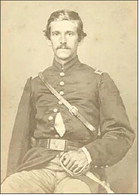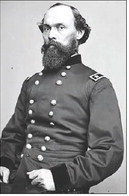Juneteenth: A History of General Order No. 3 in the Hill Country
- CMEC

- Jun 18
- 4 min read
By Paul Phillips III and Eric Hammersen
Fredericksburg Standard Radio Post - June 18, 2025
On May 8, 1846, 120 German settlers arrived to establish Fredericksburg. Other groups followed in 1846 and 1847. The Mormons established Zodiac in 1847, and Gillespie County was created out of Bexar County. The local Germans and the Mormons opposed slavery. The first African-Americans came two years later. Matilda Jackson and Millie Johnson (probably a cook and housekeeper) and children, Arkansas, Alonzo and Nathen, were the enslaved servants of Lieutenant Colonel Thomas Staniford, from Connecticut, and his wife Jane, from New York.
Staniford took command of Fort Martin Scott on Dec. 22, 1849. The five had been servants of Staniford at Jefferson Barracks, near St. Louis, before being taken to San Antonio in 1848. They were the only enslaved individuals in the county on the 1850 U.S. Census Slave Schedule and returned to San Antonio in early 1852, when Jane Staniford moved there as her husband led the 8th Infantry Regiment farther west.
Slaves in Gillespie
The 1852 tax records show two families had arrived in Gillespie County from Virginia and Tennessee — bringing 11 enslaved men and women. The 1860 Slave Schedule showed 32 enslaved African Americans in the county. Ten were at a 1,500-acre cotton farm north and south of the Pedernales River in the South Grape Creek Precinct, nine were at a farm northeast of town in the Caldwell’s Hill Post Office Precinct, eight were at a 1,476-acre farm on the south side of the Pedernales River, three were at a farm north of town in the Cherry Spring Precinct and the other two worked for a merchant in town and a herdsman.
By 1864, the Gillespie County Tax List showed the number of enslaved people had grown to 41 (about 0.0164% of the estimated total enslaved population of Texas). By the end of the Civil War in June 1865, the number dropped to 27.
Union forces
In May 1865, after the Army of Northern Virginia surrendered, General Grant ordered General Sheridan to move U.S. Army forces to Texas to establish federal control and occupy the state. Union forces included 50,000 veteran soldiers in four corps — one in Galveston, Houston and Marshall; one in Indianola and Victoria; one in Brownsville and one at Corpus Christi and along the lower Rio Grande valley — plus two cavalry divisions sent to Austin and San Antonio to patrol the Texas frontier, including the Hill Country. Major General Gordon Granger commanded the new Department of Texas.
On June 19, Major Frederick W. Emery, Granger’s adjutant, issued General Order No. 3 on behalf of the general. Emery is thought to have crafted the wording in the order. It was printed in newspapers in Galveston, then spread to other towns.
General Order No. 3 was published (in German) in the Neu Braunsfelser Zeitung on June 30 and likely made it to Fredericksburg during the first week in July. The lack of a direct road, poor road conditions in the Hill Country and extreme dangers abounding on the Texas frontier meant travel from Neu Braunfels to Fredericksburg took several days.
Based on personal narratives collected in the mid-1930s, many newly freed African Americans in Texas stayed in place and began to work for wages or as sharecroppers, while others left to look for employment elsewhere.

General Order No. 3, as published in German in the Neu Braunfelser Zeitung on June 30, 1865. – Submitted photo

General Order No. 3, as published in German in the Neu Braunfelser Zeitung on June 30, 1865. – Submitted photo

U.S. Maj. Gen. Gordon Granger, right, who commanded Union forces in Texas after the Confederate Army’s surrender, issued General Order No. 3 in 1865 that declared Texas a free state. – Photo by Army Historical Foundation
13th Amendment
Congress had passed the Thirteenth Amendment, abolishing the institution of slavery, in January 1865, and it was ratified by the required two-thirds of the states in December. Texas, which was not allowed to fully rejoin the Union until March 30, 1870, had ratified the Amendment in February. Celebrations were held in Galveston, Houston and San Antonio on June 19, 1866, later spreading to other Texas cities.
The 1870 federal census was the first to list African Americans in Texas by name, and included the surnames Blank, Dearing, DeFries, Doss, Emmerson, Halven, Henry, May, Miller, Noha, Patritch [Patrick], Russel, Smith, Thompson, Threadgill, Tinker, Treasure, Washington, Wallace and Wiley in Gillespie County. The African American population had nearly doubled, with a total of 53 individuals enumerated, ranging from four months to 80 years of age.
Juneteenth events Thursday, June 19
1 p.m. – Dedication of the Texas Historical Marker at Der Stadt Friedhof in Section C of the cemetery, located at 510 E. Schubert St., Fredericksburg.
3 p.m. – Church service at the Christian Methodist Episcopal Church, 520 E. Main St., Fredericksburg.
Landowners
In 1874, Silas Russel purchased 10 acres of land in Gillespie County, followed by another 10 acres two years later. George Washington purchased 165 acres in 1877. That same year, a one-room schoolhouse was constructed for the “public free education of the colored children.” It was built on Town Lot 198 between Town Creek and San Saba Street (Main Street) and lasted until 1922, when a new one-room schoolhouse was built on the same site. By the 1880 U.S. Census, the number of African Americans had increased to 134. Most were living in the city, but families also lived in all four county precincts. James Tinker purchased 200 acres in 1880, George Washington purchased another 100 acres in 1884 and Silas Russel bought another 88 acres in 1888.
Colored church
On May 31, 1887, Oscar Basse, the son and inheritor of Charlotte Basse’s estate, sold Town Lot 604 “… to be used for church purposes, for the use of the colored M.E. Church of Fredericksburg.”The Trustees of the Colored Methodist Episcopal Church were William McLane, Silas Russel, James Scruggins and James Tinker. Later, a footbridge was built across Town Creek from the church to Der Stadt Friedhof.On June 7, 1979, Texas proclaimed Juneteenth as a state holiday — the first state in the nation to do so. It became a federal holiday on June 17, 2021.
Phillips is a retired U.S. Army colonel and orthopedic surgeon and Hammersen is a retired U.S. Army colonel and career intelligence specialist.




Comments